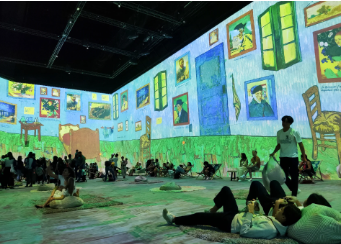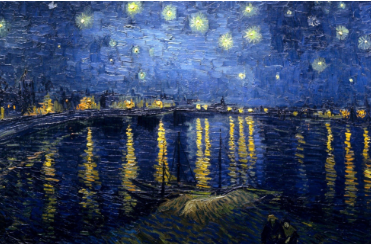Among the most famous and powerful personalities in Western art history is Vincent van Gogh. Van Gogh created almost 2,000 artworks, including 860 oil paintings and more than 1,300 watercolors, drawings, and sketches, despite leading a turbulent and very short life. His unique brushwork, vivid color palette, and emotionally charged subject matter transformed the art world.
Van Gogh’s posthumous glory has skyrocketed, establishing him as a forerunner of contemporary art even though he battled mental illness and sold only one picture over his lifetime.
From his early years and artistic awakening to his creative pinnacle and sad conclusion, this essay offers a thorough investigation of van Gogh’s life. It also looks at his ongoing legacy, which shapes the next generations of artists and enthralls viewers all around.

Formative Years
March 30, 1853, saw Vincent Willem van Gogh born in Groot-Zundert, a small town in the southern Netherlands. He was the eldest surviving son of Protestant clergyman Theodorus van Gogh and artistic mother Anna Cornelia. Growing up in a devout and sophisticated home, Vincent showed early sensitivity and introspection.
He was shy and often secluded growing up, displaying early symptoms of emotional complexity. Although he attended several boarding institutions, he never really shone academically. Thanks to family ties, van Gogh started working at the eminent art dealership Goupil & Cie at sixteen. His travels to London and Paris brought him to grandly exposed works of art. But he left the company in 1876 because of disenchantment with the art trade and spiritual direction.
Preacher and missionary
Working as a lay preacher and missionary in Belgium’s coal-mining area, Van Gogh first followed a religious route. Living among the destitute, he shared in their suffering. Though his attempts were sincere, church officials rejected his unusual approach. But this turbulent time set the roots of empathy and unvarnished human feeling that would define his work.
The Artist Awakens
Van Gogh chose to work as an artist at 27 years old. Without any official instruction, he threw himself into drawing, thinking that before dealing with color, form was absolutely crucial. Early works from this era, such as “The Potato Eaters” (1885), represent both the life of peasant workers and van Gogh’s great sympathy for the underprivileged; they are melancholy and earthy.
Van Gogh
Van Gogh was highly committed to personal learning. He examined the works of Jean-François Millet and other Realist artists who faithfully and with pathos captured the life of laborers with dignity. Though he stayed mostly self-taught and dubious of conventional academic approaches, he also temporarily registered in the Académie Royale des Beaux-Arts in Brussels. Van Gogh relocated to Paris in 1886 in order to live with his brother Theo, an art dealer by now. The relocation was transformative. Van Gogh met Post-Impressionist and Impressionist painters including Georges Seurat, Camille Pissarro, Paul Gauguin, and Claude Monet in Paris. Working with their creations produced a brighter palette, looser brushwork, and color theory and perspective experiments.
The Arles Period
artistic flowering (1888–1889 Van Gogh departed Paris’s dismal sky for the sun-drenched landscapes of Arles in southern France early in 1888. Renting the now-famous “Yellow House,” he started creating some of his most famous pieces to build a community of artists.
Arles was a moment of tremendous change in van Gogh’s technique. Strong outlines, rich yellows, and deep blues permeated his works. Works including “Sunflowers,” “The Bedroom,” “Café Terrace at Night,” and “The Night Café” highlight his special ability to provide emotional and psychological depth to everyday settings.
Arles
Arles was to Van Gogh a creative paradise. Paul Gauguin accompanied him there in October 1888, but their friendship soon soured. The conflict between the two finally resulted in a psychological breakdown during which van Gogh notably destroyed his own ear. This episode started a sequence of mental health crises that would afflict him throughout his life.
Final Years (1889–1890) Saint-Rémy and Auvers-sur-Oise
Van Gogh freely admitted himself to the Saint-Paul-de-Asylum in Saint -Rémy-de-Provence in May 1889 following the ear incident. He stayed somewhat busy despite his unstable mental state. From his cell and the surroundings,
Van Gogh created
Among the most well-known pieces Van Gogh created were “The Starry Night,” “Irises,” and “Wheatfield with Cypresses.” During this period, he also produced a collection of intensely felt self-portraits that provide a disturbing insight into his inner conflict. His art becomes more metaphorical, concentrating on the interaction among hope, sorrow, and nature. Van Gogh relocated to Auvers-sur-Oise, close to Paris, under the direction of a physician friendly to artists, Dr. Paul Gachet, in May 1890. Van Gogh painted more than 70 pieces during the next two months, evidence of his relentless brilliance and ambition. Still, his mental health was getting worse.
Reportedly self-inflicted
Van Gogh reportedly self-inflicted his gunshot wound to the chest on July 27, 1890. Two days later, on July 29, he passed away in the arms of his devastated brother Theo.
Literary style and methodologies in Van Gogh’s work are easily identifiable: whirling brushstrokes, vivid color schemes, and emotionally charged compositions. He embraced emotion, movement, and subjective vision, therefore departing from the exacting realism of the 19th century.
Often painting directly from nature, he added texture and depth using impasto techniques—thick layers of paint. His color selections were purposeful and metaphorical.
Yellow usually represented hope and warmth; blue suggested gloom and reflection.
Resisted classification
His creations resisted classification. Though he is sometimes associated with the Post-Impressionists, van Gogh’s style was much different. Influencing leaders like Edvard Munch and the German Expressionist movements, his work prepared the ground for Expressionism.
Van Gogh sold just one picture, “The Red Vineyard,” during his lifetime, and was much misinterpreted. But soon after his death, his reputation expanded mostly due to the efforts of his brother Theo’s wife, Johanna van Gogh-Bonger, who constantly championed his work and conserved his correspondence.
The museum in Amsterdam
The museum in Amsterdam and the Museum of Modern Art in New York house his paintings.
Beyond his creative impact, van Gogh has evolved into a cultural figure of the wounded genius battling against all odds in search of beauty and meaning. his
Reflections on life, art, and mental health abound in letters to Theo that still ring true with readers all around.
The legacy of Van Gogh also reaches into popular culture. Songs, publications, and events honor his vision and humanism, while movies like “Lust for Life” (1956) and “Loving Vincent” (2017) have represented his life.
Solitude
Solitude and a continuous search for meaning defined Vincent van Gogh’s life. Still, he produced an amazing collection of work spanning time and geography out of his hardships. His paintings capture the depths of the human psyche, therefore reflecting emotional landscapes rather than just visual experiences.
Van Gogh’s paintings still challenge and inspire viewers today, reminding us of the transforming potential of art. His narrative is a moving monument to the idea that even in misery, there may be beauty and that actual vision usually transcends what the eye can see.
Final thought
The museum in Amsterdam and the Museum of Modern Art in New York house his paintings.
Beyond his creative impact, van Gogh has evolved into a cultural figure of the wounded genius battling against all odds in search of beauty and meaning. His challenge and inspiration to viewers today remind us of the transforming potential of art. His narrative is a moving monument to the idea that even in misery, there may be beauty and that actual vision usually transcends what the eye can see.
Conclusion
Among the most well-known pieces Van Gogh created were “The Starry Night,” “Irises,” and “Wheatfield with Cypresses.” During this period, he also produced a collection of intensely felt self-portraits that provide a disturbing insight into his inner conflict.
His challenge and inspiration to viewers today remind us of the transforming potential of art. His narrative is a moving monument to the idea that even in misery, there may be beauty and that actual vision usually transcends what the eye can see.
FQS
1. Why is Vincent van Gogh rather well-known nowadays?
Van Gogh is well-known for his profoundly affecting use of color, emotionally expressive technique, and strong influence on modern art. His posthumous appreciation and dramatic life narrative have solidified his cultural icon reputation.
2. Among Vincent van Gogh’s most well-known pieces are what?
Among his best-known pieces are “Starry Night,” “Sunflowers,” “The Bedroom,” “Café Terrace at Night,” and “Wheatfield with Crows.”
3. During his lifetime, did van Gogh get appreciation?
No, he sold only one artwork and was essentially unknown during his lifetime. Thanks to family efforts and increasing post-impressionist art’s appeal, his reputation developed after his death.
4. From what mental diseases did van Gogh suffer?
Van Gogh underwent periods of anxiety, depression, and madness. While diagnoses differ, some researchers propose bipolar disorder, temporal lobe epilepsy, or borderline personality disorder.
5. Where may I find Van Gogh’s work right now?
Major institutions all over, notably the Van Gogh Museum in Amsterdam, have his works on view.
